Corn Straw Total Mix Dietary Supplementation of Bacillus Subtilis-Enhanced Growth Performance of Lambs by Favorably Modulating Rumen Bacterial Microbiome
Abstract
1. Introduction
2. Materials and Methods
2.1. Experimental Design, Animals, and Diet Preparation
2.2. Experimental Procedure and Sampling
2.3. Laboratory Analyses
2.3.1. Determinations of Rumen Ammonia Nitrogen (NH3-N), VFA, and Microbial Protein
2.3.2. Determination of Microbial Compositions by Sequencing
2.4. Calculation and Statistical Analysis
3. Results
3.1. Growth Performance and Carcass Characteristics
3.2. Rumen Metabolites
3.3. Bacterial Microbiome of the Rumen Fluid
Effects of B. Subtilis on Rumen Microbiota
4. Discussion
4.1. Effects of BS Supplementation on Ruminal Fermentation
4.2. Effects of BS Supplementation on Bacterial Diversity
4.3. Effects of BS Supplementation on Bacterial Abundances
5. Conclusions
Author Contributions
Funding
Institutional Review Board Statement
Informed Consent Statement
Data Availability Statement
Conflicts of Interest
References
- Wang, Y.; Nan, X.; Zhao, Y.; Jiang, L.; Wang, H.; Zhang, F.; Hua, D.; Liu, J.; Yao, J.; Yang, L.; et al. Dietary Supplementation of Inulin Ameliorates Subclinical Mastitis via Regulation of Rumen Microbial Community and Metabolites in Dairy Cows. Microbiol. Spectr. 2021, 9, e0010521. [Google Scholar] [CrossRef] [PubMed]
- Chen, H.; Guo, B.; Yang, M.; Luo, J.; Hu, Y.; Qu, M.; Song, X. Response of Growth Performance, Blood Biochemistry Indices, and Rumen Bacterial Diversity in Lambs to Diets Containing Supplemental Probiotics and Chinese Medicine Polysaccharides. Front. Vet. Sci. 2021, 8, 681389. [Google Scholar] [CrossRef] [PubMed]
- Zeitz, J.O.; Guertler, P.; Pfaffl, M.W.; Eisenreich, R.; Wiedemann, S.; Schwarz, F.J. Effect of non-starch-polysaccharide-degrading enzymes as feed additive on the rumen bacterial population in non-lactating cows quantified by real-time PCR. J. Anim. Physiol. Anim. Nutr. 2013, 97, 1104–1113. [Google Scholar] [CrossRef]
- Maake, T.W.; Aiyegoro, O.A.; Adeleke, M.A. Effects of Lactobacillus rhamnosus and Enterococcus faecalis Supplementation as Direct-Fed Microbials on Rumen Microbiota of Boer and Speckled Goat Breeds. Vet. Sci. 2021, 8, 103. [Google Scholar] [CrossRef] [PubMed]
- Monteiro, H.F.; Lelis, A.L.J.; Fan, P.; Calvo Agustinho, B.; Lobo, R.R.; Arce-Cordero, J.A.; Dai, X.; Jeong, K.C.; Faciola, A.P. Effects of lactic acid-producing bacteria as direct-fed microbials on the ruminal microbiome. J. Dairy Sci. 2022, 105, 2242–2255. [Google Scholar] [CrossRef] [PubMed]
- Jeyanathan, J.; Martin, C.; Morgavi, D.P. Screening of bacterial direct-fed microbials for their antimethanogenic potential in vitro and assessment of their effect on ruminal fermentation and microbial profiles in sheep. J. Anim. Sci. 2016, 94, 739–750. [Google Scholar] [CrossRef]
- Nie, L.; Zhang, A.; Jiang, N.; Yang, Z.N. The application of probiotics in the production of juvenile ruminants. Feed Expo. 2017, 9, 11–14. [Google Scholar]
- Pan, K.; He, M. Research and application of microbial additives in my country. Vet. Med. Feed Addit. 2002, 4, 35–37. [Google Scholar]
- Chen, G.; Pan, K.; Yuan, C.; Shen, J. Study on the effect of Bacillus PAS38 and β-mannan on 5-HT in rabbit small intestine. Chin. Anim. Husb. Newsl. 2008, 22, 11–13. [Google Scholar]
- Choi, P.; Rhayat, L.; Pinloche, E.; Devillard, E.; De Paepe, E.; Vanhaecke, L.; Haesebrouck, F.; Ducatelle, R.; Van Immerseel, F.; Goossens, E. Bacillus Subtilis 29784 as a Feed Additive for Broilers Shifts the Intestinal Microbial Composition and Supports the Production of Hypoxanthine and Nicotinic Acid. Animals 2021, 11, 1335. [Google Scholar] [CrossRef]
- Chang, M.; Ma, F.; Wei, J.; Liu, J.; Nan, X.; Sun, P. Live Bacillus subtilis natto promotes rumen fermentation by modulating rumen microbiota in vitro. Animals 2021, 11, 1519. [Google Scholar] [CrossRef] [PubMed]
- Sun, P.; Wang, J.Q.; Deng, L.F. Effects of Bacillus subtilis natto on milk production, rumen fermentation and ruminal microbiome of dairy cows. Animal 2013, 7, 216–222. [Google Scholar] [CrossRef] [PubMed]
- Wang, Z.; He, Z.; Beauchemin, K.A.; Tang, S.; Zhou, C.; Han, X.; Wang, M.; Kang, J.; Odongo, N.E.; Tan, Z. Comparison of two live Bacillus species as feed additives for improving in vitro fermentation of cereal straws. Anim. Sci. J. 2016, 87, 27–36. [Google Scholar] [CrossRef]
- EFSA Panel on Additives and Products or Substances used in Animal Feed (FEEDAP); Bampidis, V.; Azimonti, G.; Bastos, M.L.; Christensen, H.; Dusemund, B.; Fašmon Durjava, M.; Kouba, M.; López-Alonso, M.; López Puente, S.; et al. Safety and efficacy of a feed additive consisting of Bacillus subtilis strains CNCM I-4606, CNCM I-5043 and CNCM I-4607 and Lactococcus lactis CNCM I-4609 for all animal species (Nolivade). EFSA J. 2021, 19, e06907. [Google Scholar] [CrossRef]
- Mingmongkolchai, S.; Panbangred, W. Bacillus probiotics: An alternative to antibiotics for livestock production. J. Appl. Microbiol. 2018, 124, 1334–1346. [Google Scholar] [CrossRef]
- Zheng, D.Z. Application of Calsporin in livestock feed. Anim. Husb. Mark. 2007, 10, 49–51. [Google Scholar]
- Geng, C. Comparison of Growth Performance, Carcass Index and Beef Quality of Fattening Cattle Fed with Active Yeast and Yeast Culture. Ph.D. Dissertation, China Agricultural University, Beijing, China, 2015. [Google Scholar]
- Feng, Z.; Gao, M. Improvement of the method for determination of ammonia nitrogen content in rumen liquid by colorimetry. Inn. Mong. Anim. Husb. Sci. 1993, 4, 40–41. [Google Scholar]
- Bradford, M.M. A rapid and sensitive method for the quantitation of microgram quantities of protein utilizing the principle of protein-dye binding. Anal. Biochem. 1976, 72, 248–254. [Google Scholar] [CrossRef]
- Stewart, C.S.; Duncan, S.H. The effect of avoparcin on cellulolytic bacteria of the ovine rumen. J. Gen. Microbiol. 1985, 131, 427–435. [Google Scholar] [CrossRef][Green Version]
- Rogers, S.O.; Bendich, A.J. Extraction of DNA from plant tissues. In Plant Molecular Biology Manual; Springer: Dordrecht, The Netherlands, 1989; pp. 73–83. [Google Scholar]
- Lee, P.Y.; Costumbrado, J.; Hsu, C.Y.; Kim, Y.H. Agarose gel electrophoresis for the separation of DNA fragments. J. Vis. Exp. 2012, 62, 3923. [Google Scholar] [CrossRef]
- Martin, M. Cutadapt removes adapter sequences from high-throughput sequencing reads. EMBnet J. 2011, 17, 10–12. [Google Scholar] [CrossRef]
- Edgar, R.C.; Haas, B.J.; Clemente, J.C.; Quince, C.; Knight, R. UCHIME improves sensitivity and speed of chimera detection. Bioinformatics 2011, 27, 2194–2200. [Google Scholar] [CrossRef]
- Haas, B.J.; Gevers, D.; Earl, A.M.; Feldgarden, M.; Ward, D.V.; Giannoukos, G.; Ciulla, D.; Tabbaa, D.; Highlander, S.K.; Sodergren, E.; et al. Chimeric 16S rRNA sequence formation and detection in Sanger and 454-pyrosequenced PCR amplicons. Genome Res. 2011, 21, 494–504. [Google Scholar] [CrossRef]
- Edgar, R.C. UPARSE: Highly accurate OTU sequences from microbial amplicon reads. Nat. Methods 2013, 10, 996–998. [Google Scholar] [CrossRef]
- Wurilege. The Effect of Adding Bacillus subtilis to the Diet on the Growth Performance, Blood Indicators and Rumen Microbes of Fattening Sheep. Master’s Thesis, Inner Mongolia Agricultural University, Hohhot, China, 2019. [Google Scholar] [CrossRef]
- Xiros, C.; Shahab, R.L.; Studer, M.H. A cellulolytic fungal biofilm enhances the consolidated bioconversion of cellulose to short chain fatty acids by the rumen microbiome. Appl. Microbiol. Biotechnol. 2019, 103, 3355–3365. [Google Scholar] [CrossRef] [PubMed]
- Baldwin, R.L., VI; Connor, E.E. Rumen Function and Development. Vet. Clin. N. Am. Food Anim. Pract. 2017, 33, 427–439. [Google Scholar] [CrossRef] [PubMed]
- Kawauchi, D.; Angthong, W.; Keaokliang, O.; Ishida, T.; Takahashi, T.; Kawashima, T. Effect of feeding Bacillus subtilis on rumen fermentation, blood metabolites, nutrient digestibility, and energy and nitrogen balances in non-lactating crossbred cows. Anim. Sci. J. 2021, 92, e13531. [Google Scholar] [CrossRef] [PubMed]
- Xu, Y.; Yu, Y.; Shen, Y.; Li, Q.; Lan, J.; Wu, Y.; Zhang, R.; Cao, G.; Yang, C. Effects of Bacillus subtilis and Bacillus licheniformis on growth performance, immunity, short chain fatty acid production, antioxidant capacity, and cecal microflora in broilers. Poult. Sci. 2021, 100, 101358. [Google Scholar] [CrossRef] [PubMed]
- Caulier, S.; Nannan, C.; Gillis, A.; Licciardi, F.; Bragard, C.; Mahillon, J. Overview of the Antimicrobial Compounds Produced by Members of the Bacillus subtilis Group. Front. Microbiol. 2019, 10, 302. [Google Scholar] [CrossRef]
- Devyatkin, V.; Mishurov, A.; Kolodina, E. Probiotic effect of Bacillus subtilis B-2998D, B-3057D, and Bacillus licheniformis B-2999D complex on sheep and lambs. J. Adv. Vet. Anim. Res. 2021, 8, 146–157. [Google Scholar] [CrossRef]
- Konopka, A. What is microbial community ecology? ISME J. 2009, 3, 1223–1230. [Google Scholar] [CrossRef] [PubMed]
- Zhang, Y.K.; Zhang, X.X.; Li, F.D.; Li, C.; Li, G.Z.; Zhang, D.Y.; Song, Q.Z.; Li, X.L.; Zhao, Y.; Wang, W.M. Characterization of the rumen microbiota and its relationship with residual feed intake in sheep. Animal 2021, 15, 100161. [Google Scholar] [CrossRef] [PubMed]
- Okazaki, Y.; Sekita, A.; Chiji, H.; Kato, N. Consumption of lily bulb modulates fecal ratios of firmicutes and bacteroidetes phyla in rats fed a high-fat diet. Food Sci. Biotechnol. 2016, 25 (Suppl. S1), 153–156. [Google Scholar] [CrossRef] [PubMed]
- Stojanov, S.; Berlec, A.; Štrukelj, B. The Influence of Probiotics on the Firmicutes/Bacteroidetes Ratio in the Treatment of Obesity and Inflammatory Bowel disease. Microorganisms 2020, 8, 1715. [Google Scholar] [CrossRef]
- Ren, Z.; Fang, H.; Zhang, J.; Wang, R.; Xiao, W.; Zheng, K.; Yu, H.; Zhao, Y. Dietary Aronia melanocarpa Pomace Supplementation Enhances the Expression of ZO-1 and Occludin and Promotes Intestinal Development in Pigs. Front. Vet. Sci. 2022, 9, 904667. [Google Scholar] [CrossRef]
- Wang, Y.; Huang, J.M.; Zhou, Y.L.; Almeida, A.; Finn, R.D.; Danchin, A.; He, L.S. Phylogenomics of expanding uncultured environmental Tenericutes provides insights into their pathogenicity and evolutionary relationship with Bacilli. BMC Genom. 2020, 21, 408. [Google Scholar] [CrossRef]
- Santarossa, S.; Sitarik, A.R.; Johnson, C.C.; Li, J.; Lynch, S.V.; Ownby, D.R.; Ramirez, A.; Yong, G.L.M.; Cassidy-Bushrow, A.E. Associations of physical activity with gut microbiota in pre-adolescent children. Phys. Act. Nutr. 2021, 25, 24–37. [Google Scholar] [CrossRef]
- Sun, D.; Bai, R.; Zhou, W.; Yao, Z.; Liu, Y.; Tang, S.; Ge, X.; Luo, L.; Luo, C.; Hu, G.F.; et al. Angiogenin maintains gut microbe homeostasis by balancing α-Proteobacteria and Lachnospiraceae. Gut 2021, 70, 666–676. [Google Scholar] [CrossRef]
- Lozupone, C.A.; Li, M.; Campbell, T.B.; Flores, S.C.; Linderman, D.; Gebert, M.J.; Knight, R.; Fontenot, A.P.; Palmer, B.E. Alterations in the gut microbiota associated with HIV-1 infection. Cell Host Microbe 2013, 14, 329–339. [Google Scholar] [CrossRef]
- Xu, Y.; Ai, C.; Jiang, P.; Sun, X.; Liu, Y.; Jiang, G.; Song, S. Oligosaccharides from Gracilaria lemaneiformis better attenuated high fat diet-induced metabolic syndrome by promoting the Bacteroidales proliferation. Food Funct. 2020, 11, 1049–1062. [Google Scholar] [CrossRef]

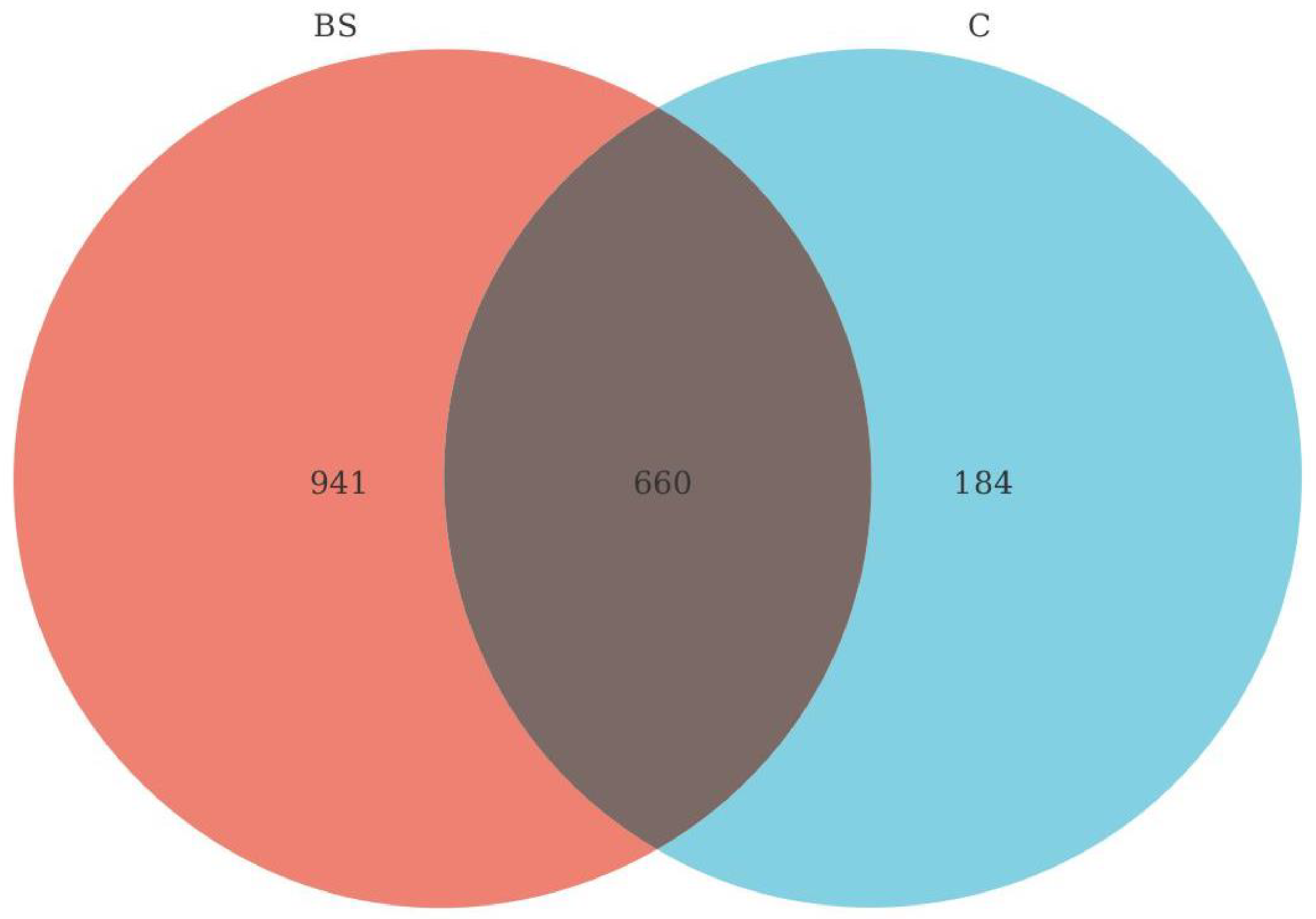
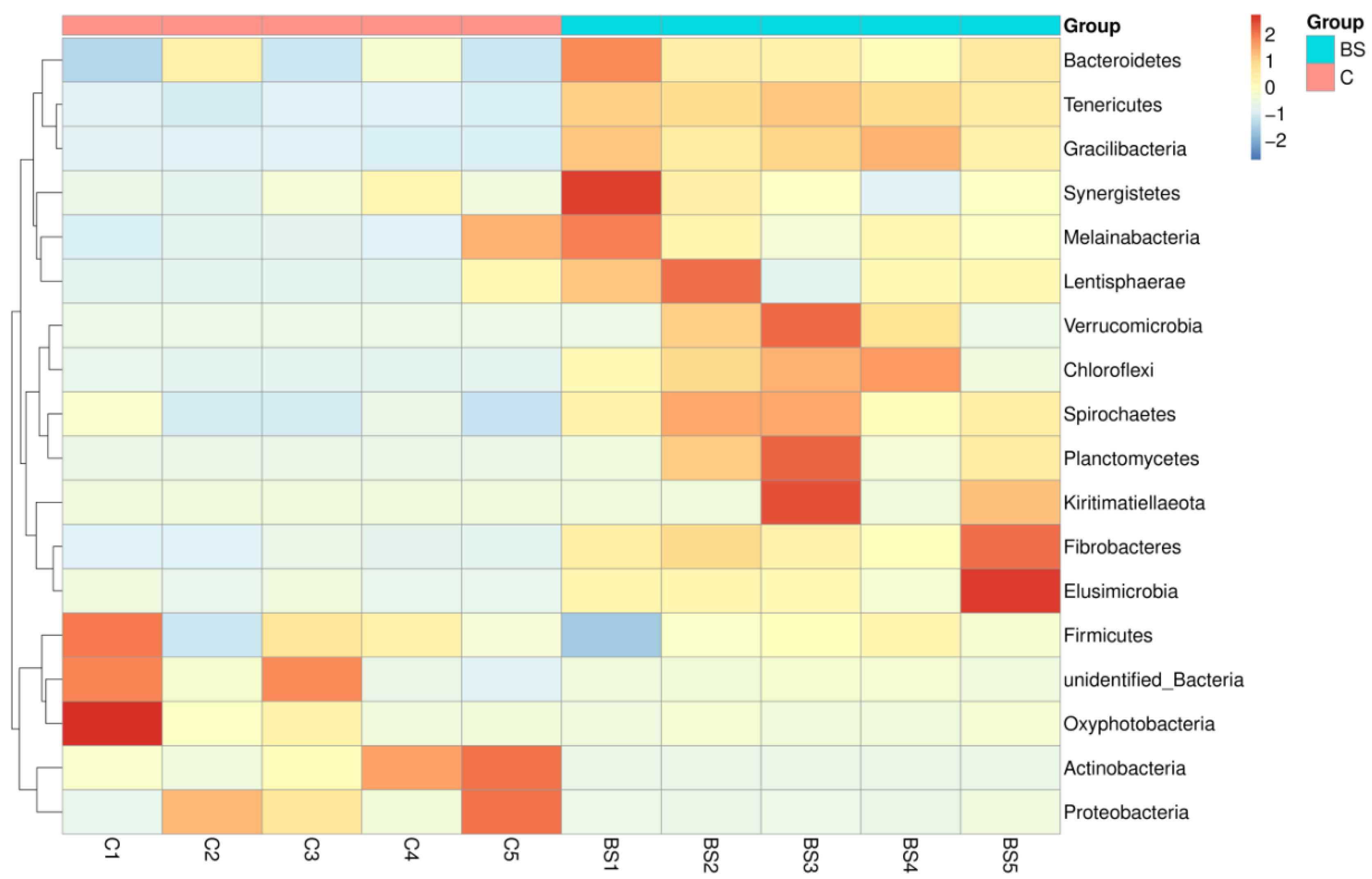
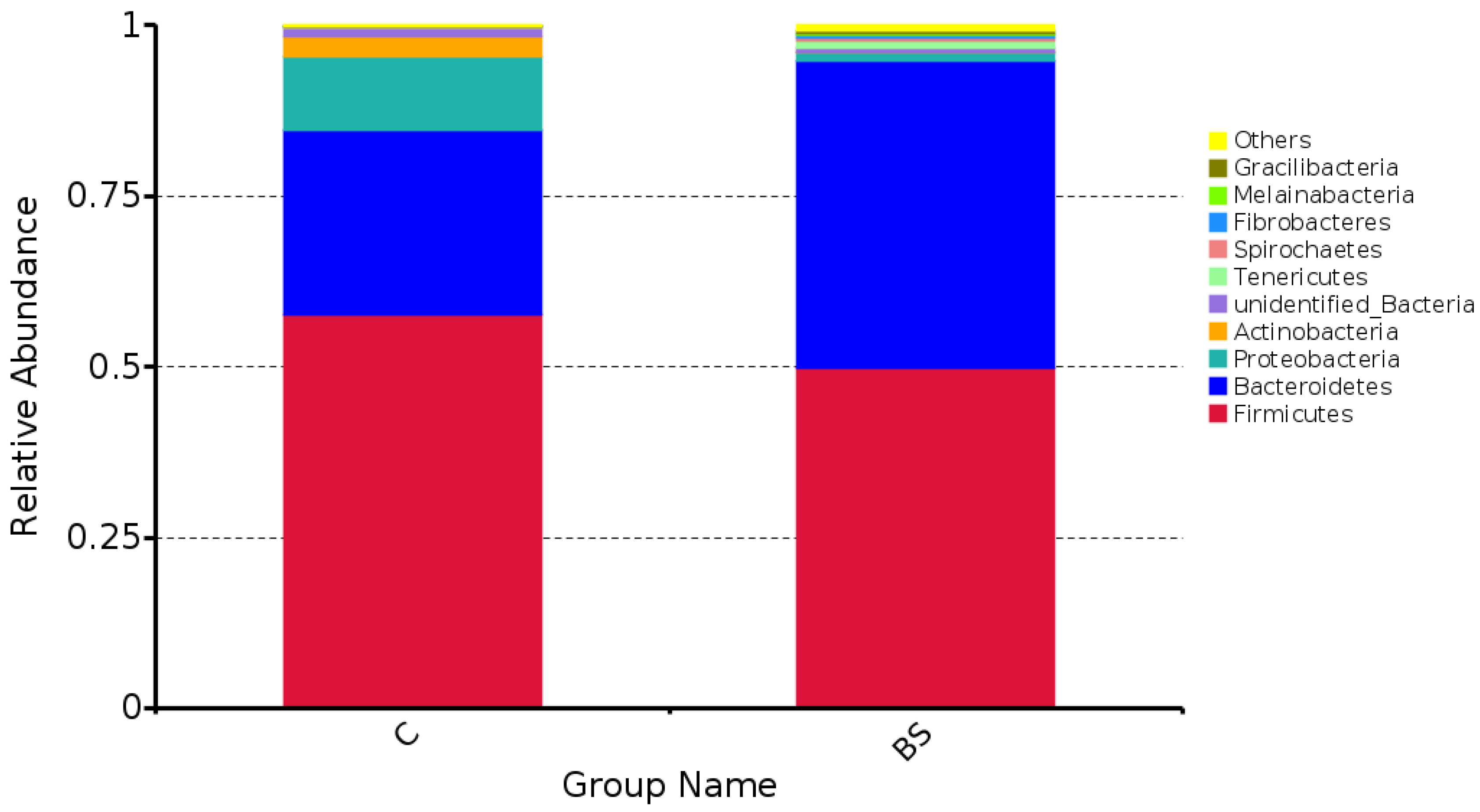
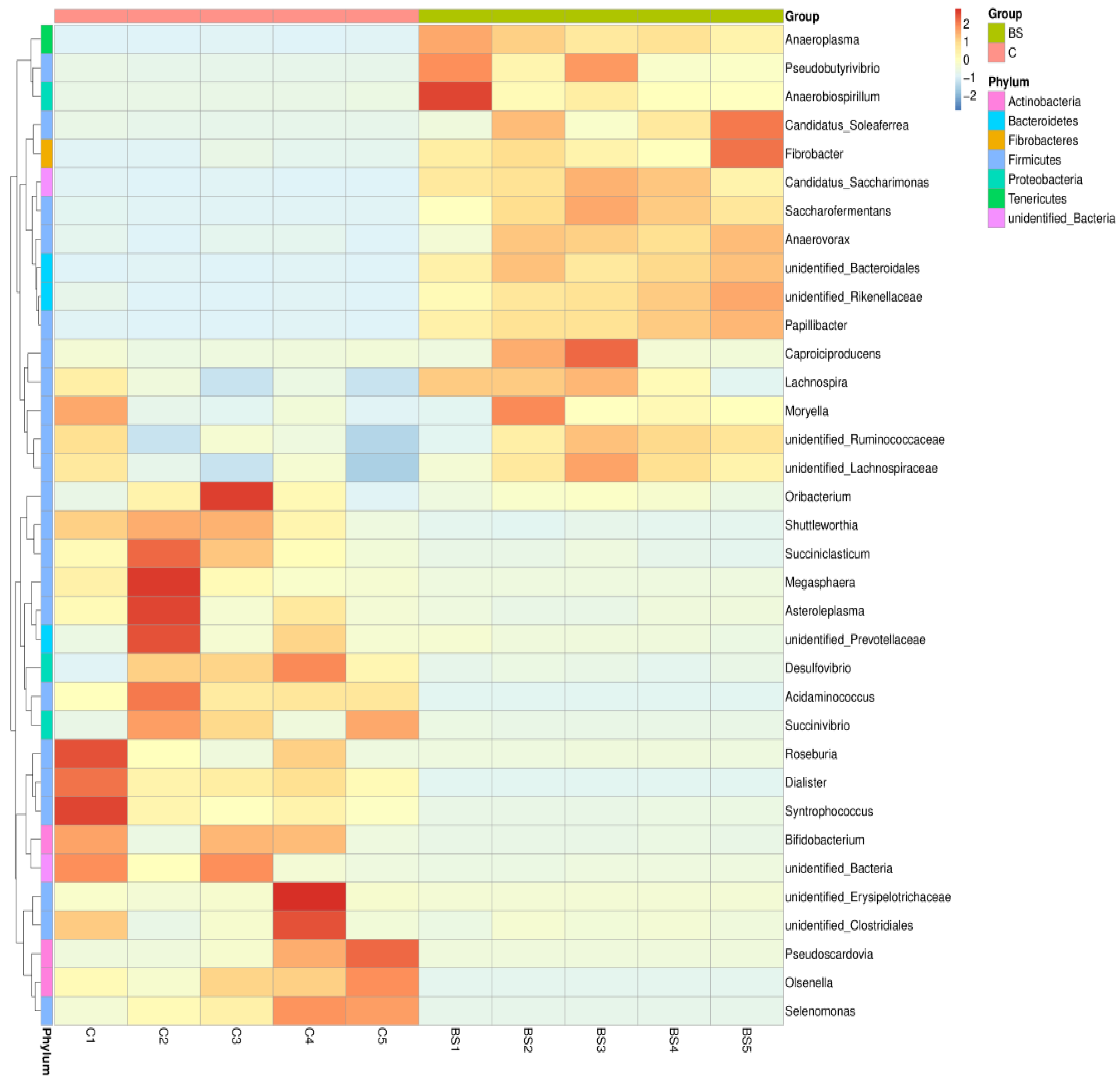
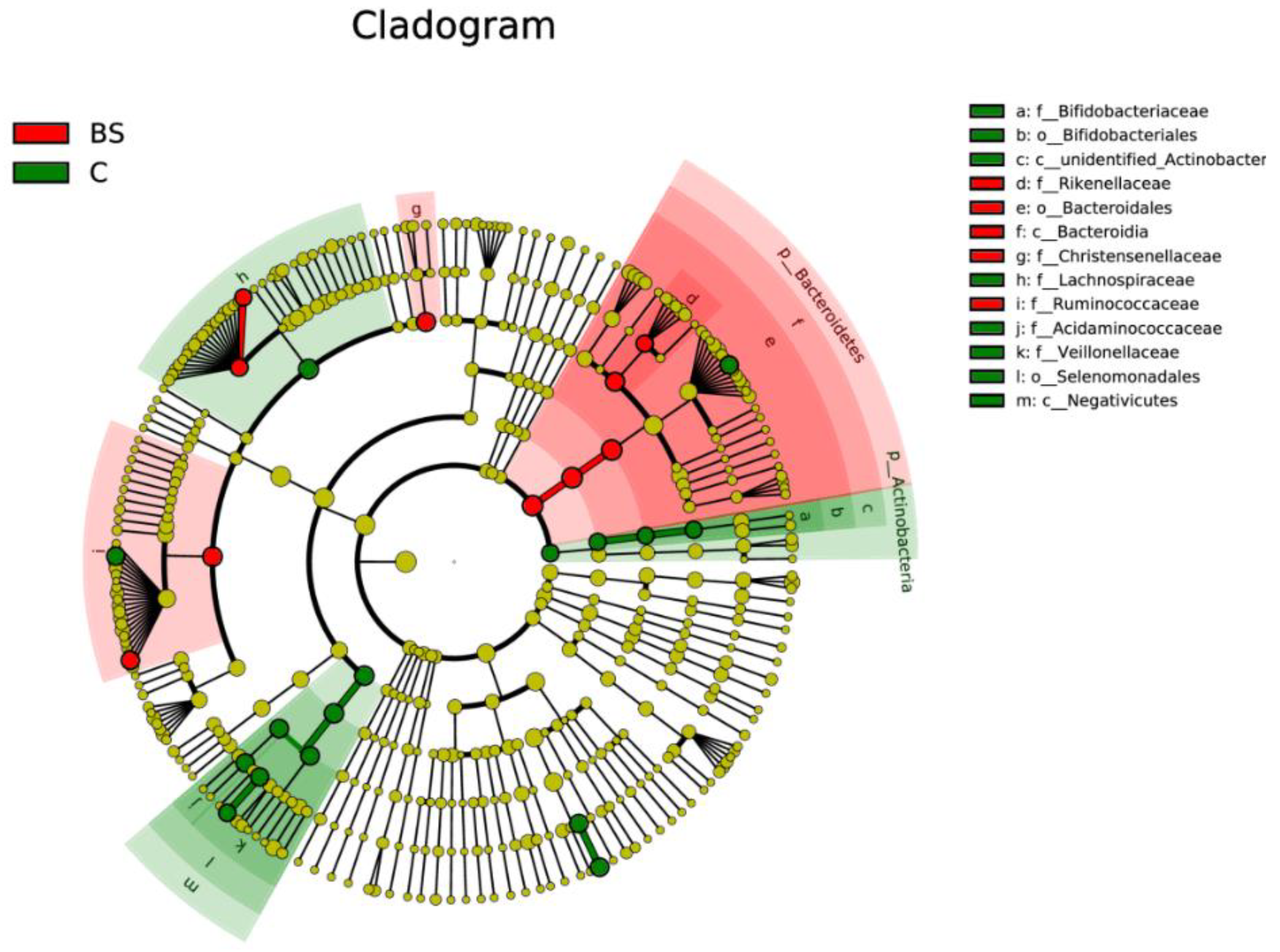
| Raw Material | Control (C) Group | Bacillus subtilis (BS) Group | ||
|---|---|---|---|---|
| First Stages | Later Stages | First Stages | Later Stages | |
| Corn (%) | 45.00 | 53.08 | 45.00 | 53.08 |
| DDGS (%) | 23.00 | 19.54 | 23.00 | 19.54 |
| Soybean meal (%) | 4.28 | 1.67 | 4.28 | 1.67 |
| 1% additive (%) | 0.76 | 0.76 | 0.76 | 0.76 |
| Stone powder (%) | 1.00 | 1.00 | 1.00 | 1.00 |
| NH4Cl (%) | 0.42 | 0.42 | 0.42 | 0.42 |
| NaCl (%) | 0.50 | 0.50 | 0.50 | 0.50 |
| NaHCO3 (%) | 0.42 | 0.42 | 0.42 | 0.42 |
| Bacteria preparation (%) | 0 | 0 | 0.03 | 0.03 |
| Soybean hulls (%) | 6.93 | 2.79 | 6.90 | 2.76 |
| Corn stalks (%) | 17.69 | 19.82 | 17.69 | 19.82 |
| Total (%) | 100 | 100 | 100 | 100 |
| Nutrient content | ||||
| Digestive energy (MJ/kg) | 89.13 | 88.27 | 88.63 | 87.98 |
| Ash (%) | 6.15 | 6.11 | 6.24 | 6.10 |
| CP (%) | 14.91 | 13.86 | 14.67 | 13.80 |
| EE (%) | 5.09 | 3.63 | 5.02 | 3.83 |
| NDF (%) | 29.89 | 25.72 | 28.17 | 25.40 |
| DNF (%) | 15.24 | 12.14 | 15.19 | 12.03 |
| ADF (%) | 3.51 | 2.95 | 3.68 | 2.88 |
| Ca (%) | 0.51 | 0.42 | 0.60 | 0.48 |
| P (%) | 0.40 | 0.35 | 0.45 | 0.35 |
| Index | C | BS | p-Value |
|---|---|---|---|
| pH | 6.6 ± 0.31 | 6.7 ± 0.32 | 0.164 |
| NH3-N; mg/100 mL | 13.2 ± 0.98 | 11.6 ± 0.81 | 0.133 |
| Microbial protein; mg/L | 3.9 ± 0.64 | 5.8 ± 0.36 | 0.050 |
| Total VFA; mmol/L | 27.1 ± 7.48 | 23.9 ± 3.85 | 0.450 |
| Acetate; % | 70.9 ± 2.77 | 74.2 ± 1.87 | <0.001 |
| Propionate; % | 21.4 ± 2.96 | 14.7 ± 4.97 | <0.001 |
| Iso-butyrate; % | 2.5 ± 0.90 | 4.8 ± 2.31 | 0.011 |
| Butyrate; % | 5.1 ± 1.15 | 6.4 ± 1.20 | 0.010 |
| Acetate/propionate | 3.4 ± 0.51 | 5.6 ± 1.89 | <0.001 |
| Indices | C | BS | p-Value |
|---|---|---|---|
| Observed species | 397.6 ± 155.89 | 1215.6 ± 67.60 | <0.001 |
| Shannon | 5.0 ± 0.56 | 8.0 ± 0.54 | <0.001 |
| Chao1 | 484.6 ± 36.15 | 1279.4 ± 82.33 | <0.001 |
| ACE | 498.1 ± 41.92 | 1282.4 ± 79.94 | <0.001 |
| PD whole tree | 39.7 ± 10.30 | 88.6 ± 3.39 | <0.001 |
| Taxonomy | C | BS | p-Value |
|---|---|---|---|
| Firmicutes | 57.7 ± 14.20 | 49.9 ± 8.76 | 0.322 |
| Bacteroidetes | 26.9 ± 10.10 | 45.0 ± 8.67 | 0.016 |
| Proteobacteria | 10.8 ± 9.45 | 1.3 ± 0.37 | 0.052 |
| Actinobacteria | 2.8 ± 2.61 | 0.0 ± 0.01 | 0.071 |
| Tenericutes | 0.1 ± 0.035 | 1.1 ± 0.13 | <0.001 |
| Others | 1.6 ± 1.34 | 2.2 ± 0.13 | 0.241 |
| Index | C | BS | p-Value |
|---|---|---|---|
| unidentified_Ruminococcaceae | 6.5 ± 3.02 | 9.9 ± 2.63 | 0.092 |
| unidentified_Lachnospiraceae | 2.2 ± 1.72 | 4.8 ± 1.46 | 0.036 |
| unidentified_Rikenellaceae | 0.1 ± 0.13 | 2.7 ± 0.75 | <0.001 |
| unidentified_Prevotellaceae | 6.2 ± 5.60 | 2.1 ± 0.41 | 0.138 |
| unidentified_Bacteroidales | 0.1 ± 0.03 | 1.6 ± 0.31 | <0.001 |
| Saccharofermentans | 0.0 ± 0.02 | 1.50 ± 0.51 | 0.003 |
| Succiniclasticum | 7.7 ± 5.44 | 1.0 ± 0.33 | 0.025 |
| Succinivibrio | 7.8 ± 6.86 | 0.0 ± 0.04 | 0.035 |
| Dialister | 6.2 ± 2.97 | 0.0 ± 0.01 | 0.004 |
| Pseudoscardovia | 2.0 ± 2.45 | 0.0 ± 0.00 | 0.23 |
| unidentified_Clostridiales | 1.9 ± 1.95 | 0.58 ± 0.16 | 0.176 |
| Syntrophococcus | 1.7 ± 1.42 | 0.1 ± 0.035 | 0.036 |
| Roseburia | 1.4 ± 1.66 | 0.0 ± 0.01 | 0.108 |
| Selenomonas | 1.4 ± 0.88 | 0.0 ± 0.00 | 0.095 |
| Shuttleworthia | 1.3 ± 0.73 | 0.1 ± 0.03 | 0.005 |
| Others | 53.50 ± 0.64 | 75.62 ± 5.27 | 0.002 |
Disclaimer/Publisher’s Note: The statements, opinions and data contained in all publications are solely those of the individual author(s) and contributor(s) and not of MDPI and/or the editor(s). MDPI and/or the editor(s) disclaim responsibility for any injury to people or property resulting from any ideas, methods, instructions or products referred to in the content. |
© 2022 by the authors. Licensee MDPI, Basel, Switzerland. This article is an open access article distributed under the terms and conditions of the Creative Commons Attribution (CC BY) license (https://creativecommons.org/licenses/by/4.0/).
Share and Cite
Gao, Y.; Wei, W.; Tian, F.; Li, J.; Wang, Y.; Qi, J.; Xue, S. Corn Straw Total Mix Dietary Supplementation of Bacillus Subtilis-Enhanced Growth Performance of Lambs by Favorably Modulating Rumen Bacterial Microbiome. Fermentation 2023, 9, 32. https://doi.org/10.3390/fermentation9010032
Gao Y, Wei W, Tian F, Li J, Wang Y, Qi J, Xue S. Corn Straw Total Mix Dietary Supplementation of Bacillus Subtilis-Enhanced Growth Performance of Lambs by Favorably Modulating Rumen Bacterial Microbiome. Fermentation. 2023; 9(1):32. https://doi.org/10.3390/fermentation9010032
Chicago/Turabian StyleGao, Yuan, Wurilege Wei, Feng Tian, Jiuyue Li, Yufei Wang, Jingwei Qi, and Shuyuan Xue. 2023. "Corn Straw Total Mix Dietary Supplementation of Bacillus Subtilis-Enhanced Growth Performance of Lambs by Favorably Modulating Rumen Bacterial Microbiome" Fermentation 9, no. 1: 32. https://doi.org/10.3390/fermentation9010032
APA StyleGao, Y., Wei, W., Tian, F., Li, J., Wang, Y., Qi, J., & Xue, S. (2023). Corn Straw Total Mix Dietary Supplementation of Bacillus Subtilis-Enhanced Growth Performance of Lambs by Favorably Modulating Rumen Bacterial Microbiome. Fermentation, 9(1), 32. https://doi.org/10.3390/fermentation9010032




